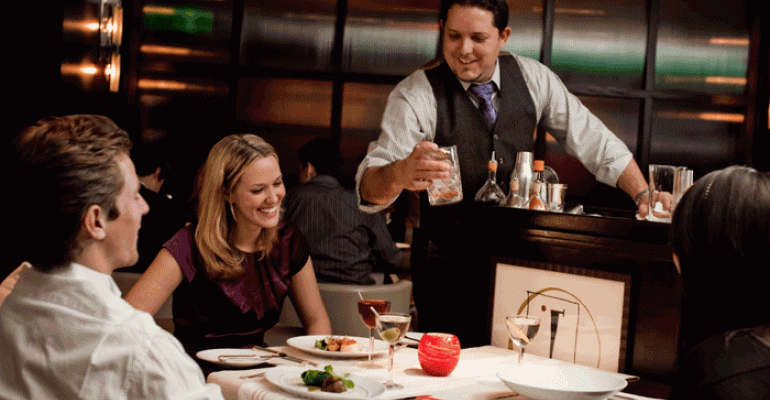Many restaurants, especially those with limited bar space, are turning to tableside cocktail service to provide more customers with the hand-crafted drink experience.
Toby Maloney of Alchemy Consulting turned to an old-fashioned solution as he developed the bar program at New York's Bar Seven Five, which does not have a standard bar setup.
Inspired by the cocktail service on the historical Pullman Company trains, in which bartenders created drinks and had them finished tableside, Maloney ordered custom-made cocktail caddies for Bar Seven Five.
"When you don't have a bar itself, so much of the show and experience is the sound of the shaking drink, the look of it being poured into the glass," Maloney said. "There's something so very visceral, and that's one of the great things about being able to do tableside service."
If a customer orders a mojito at Bar Seven Five, Maloney explained, a bartender would bruise the mint and add ingredients for the drink and ice into a cobbler shaker. The shaker is placed into a caddy along with the necessary glassware and straw. The caddies also have special compartments that hold other accoutrements like beverage napkins and are designed in a way that everything can be carried one-handed to tables. The server then shakes and serves the mojito to the guest at the table.
Charles Joly, chief mixologist for The Drawing Room at Le Passage Restaurant in Chicago, uses tableside service to enhance guest experience where bar seating is limited.
"We have a relatively small physical bar, so the majority of our patrons are seated at tables," he said. "With the amount of detail that goes into our cocktails and with the knowledge that our staff has, the bar is the best seat in the house, but you can't seat 75 people at the bar."
Joly began designing a cart based on a rolling bar cart design made by the Brunswick Corporation, an Illinois-based company known for making bars and saloons in the 19th century. The cart comes with numerous drawers and compartments to hold necessary tools and ingredients.
Fifth Floor Restaurant and Lounge at Hotel Palomar in San Francisco, a Kimpton Hotel property, takes a similar tact, using refurbished cheese carts for cocktail service.
"You can really only fit about six or seven people at the bar. It's a beautiful bar, but the way that it's built, it's just small but we have a big lounge," said Jacques Bezuidenhout, mixologist and chief consultant for the Kimpton Hotel and Restaurant Group.
Method of delivery and service style affect staff training for tableside service. At The Drawing Room, only master bartenders serve the drinks, all of which can be made on the cart. This requires the bar staff to man both the bar and the cart, with the latter service requiring customer to make a request to their server.
"I'm really sensitive to time of execution from when the tickets come in to when the drinks can be delivered. I think you can make a handcrafted cocktail or an artisan cocktail and it shouldn't take 15 minutes," Joly said. "If I can't execute the drink right behind the bar it's not going to work on the cart for sure."
At Fifth Floor, servers and bartenders are both trained in cocktail making. In addition, the drink cart's limited space requires a separate menu of cocktails focused on simple classics, such as the martini or Negroni.
Additional measures, such stocking smaller bottles of vermouth to ensure a fresher product, set up the servers for success, Bezuidenhout said.
"We want anybody to be able to just jump and go out there and make these drinks," he said. "More importantly than the technique, what we can't teach is personality and we want that personality to be out on the floor taking that extra step."
Bar Seven Five also trains servers to serve cocktails because of its table-only bar service.
"Unlike most other cocktail bars, where there's twice the number of bartenders, there's half the amount of bartenders than servers," Maloney said.
Instead of "dumbing drinks down," Maloney said the drinks on Bar Seven Five's menu were all tested to make sure they stand up to tableside service.
While the bartenders are usually in charge of assembling the drinks that are finished tableside by servers, training is just as rigorous for servers, since they are responsible for making sure a well-made drink arrives before the guest in good quality.
"Our training is very vigorous," Maloney said. "It's a five-day training period, and everybody is trained the same. The servers know as much as the bartenders do, down to the numbers of drops of bitters used in a drink…servers can pour, jigger and they can stir."
Tableside service also comes with its own unique financial costs. At Bar Seven Five, the custom-made caddies definitely were an additional cost, and the heavy use of individual shakers meant purchasing 300 shakers. Joly said the custom bar carts for The Drawing Room cost around $1,400 each, but he compared the cost to ordering any other custom-built furniture for a restaurant or bar.
Contact Sonya Moore at [email protected].




